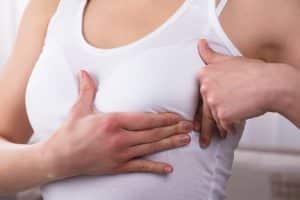What to Do If There’s a Lump On Your Breast

What Should I Do If I Find a Lump on My Breast?
First things first, see you doctor. Your doctor will give you a thorough examination and refer you for further testing if necessary. These tests can include:
- A diagnostic mammogram
- A fine needle aspiration (a small amount of fluid is removed from the lump to send for analysis)
- An ultrasound
- A biopsy
Not all breast abnormalities will require testing. For example, many fluid-filled cysts occur during your menstrual cycle. Your doctor may examine it and ask you to come back for a follow up after the end of your cycle. If the cyst is gone, your doctor will reassure you that this condition is a normal part of your cycle and make note of it in your health history.
Why Do Benign Breast Abnormalities Form?
There’s a lot of different anatomy that forms a breast. Breasts contain fat, glandular tissue, connective tissue, nerves, and blood vessels. They also contain a complex milk-producing system containing lobules that produce milk and ducts that direct milk to the nipples. All of this differing anatomy adds up to a bumpy landscape prone to producing the occasional benign lump.
Many benign breast lumps are associated with the menstrual cycle due to normal fluctuations in hormone levels. Some lumps are the result of injury to the breast. Some common benign breast lumps include:
Fibrocystic Variations
Caused by hormonal fluctuations, this condition makes breasts feel grainy or ropy. Almost half of menstruating women experience this condition at some point.
Cysts
These are fluid-filled oval or round sacs usually one to two inches across. They can be tender and come and go over the course of your menstrual cycle.
Fibroadenoma
Teenage girls and young women tend to get these round and hard moveable lumps that range from microscopic to marble-sized.
Fat Necrosis
This condition occurs when round, firm bumps form after injury to the breast. More prevalent in obese women or those with large breasts, your doctor will monitor the lump or surgically remove it.
Nipple Discharge
Depending on the color of the discharge, this condition is usually associated with fibrocystic changes caused by hormones, breast injury, or infection.
Mastitis
Usually affecting breastfeeding mothers, this condition causes painful redness and swelling due to an infection in the milk ducts. Treatment includes warm compresses and antibiotics.
For a peace of mind, always visit a doctor to get a diagnosis on any lump you find in your breast. Although many of the benign conditions mentioned above resolve on their own, some may need to be monitored or removed to ensure your overall health.
Visit PURE Mammography for Your Next Mammogram
Keep your breast health at the forefront by scheduling an annual mammogram at PURE Mammography. As Long Island’s premier breast imaging center, we perform state-of-the-art 3D mammography in a spa-like setting to ensure your comfort while delivering outstanding patient care. Stop in today for your mammogram or contact us online to learn more.